Webinar: Get on top of your game with the newest TPA methods

When I first joined Siemens PLM Software, Dirk De Vis, Vice-President of Simcenter Engineering and Consulting services, explained me the different types of projects his engineering team executes. Before anything else, he put a glass of water on the table and slammed his fist on the table. Obviously, the water was disturbed, splashing over the edge of the glass. My first notion of the source-transfer-receiver approach…
As you understand from this example, a noise and vibration issue originates from a source, which is transferred via one (or more) transfer paths to a given receiver location. Transfer path analysis, or in short TPA, is a methodical approach to vibro-acoustic design. It enables you to quantify the various sources and their paths, figure out which are important, which contribute to the noise issues and which ones cancel each other out.
The source-transfer-receiver concept nor TPA approach are new. All over the world, automotive engineers apply it to investigate and understand a product’s noise, vibration & harshness (NVH) performance. Different TPA methods are available: test-based and/or simulation-based. The preferred methodology depends on the structure, single or multi-reference sources, and the stage of the development.
Although, traditional approaches to transfer path analysis such as: airborne loads estimation, acoustic source quantification, structure-borne loads estimation, multi-reference TPA and energetic power-based ASQ are still relevant and widely employed, new methods are being developed.

Latest technologies to quantify the various sources and their contributions to noise and vibrations.At Simcenter, you’ll find engineers with unparalleled NVH experience. And they don’t sit still. New methodologies are being tried out and, if successful, integrated in the daily work and projects. If our customers agree? Absolutely!
Customers on top of their game!
Faster results, more accurate, better product refinement, and as a consequence faster troubleshooting at reduced cost, our customers are on top of their game. They apply TPA to benchmarking and target setting, vehicle development and pass-by noise engineering. Additionally, these new TPA methods empower suppliers to predict how their system will perform not just in one vehicle, but in a whole series of different variants. Component-based TPA using blocked forces is a prime example of how new TPA methodologies put the relationship between OEMs and suppliers in a completely new perspective.
On November 20, Automotive Solution Manager and NVH expert, Steven Dom, presents a live webinar: Better & faster vehicle NVH insights using the latest transfer path analysis methods. He will explain the range of methods from traditional mount stiffness and matrix inversion approaches over OPAX, strain-based TPA and time-domain TPA to model-based TPA and component-based TPA, illustrated with application examples.
Register here for the webinar and learn how to:
- Obtain an overview of the different TPA methodologies and their applications
- Improve road noise and comfort using strain sensors
- Investigate transient effects applying time-domain and model-based TPA
- Predict NVH behavior of source-components before integration using component-based TPA
Live webinar: Better & faster vehicle NVH insights using the latest transfer path analysis methods
https://www.plm.automation.siemens.com/global/en/webinar/transfer-path-analysis-tpa/44276


